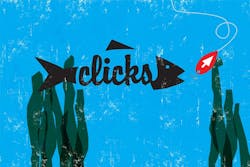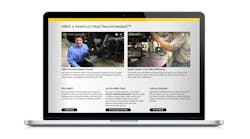Perfection Paint & Body in Vero Beach, Fla., got its first website a little over two years ago. But co-owner Julie Biron says it just wasn’t generating much traffic. The shop was buried several pages deep in Internet search results, and consumers weren’t finding the business.
So, Biron decided to add an online pay-per-click (PPC) advertising campaign to her suite of digital marketing strategies. Through her PPC campaign, Biron has business advertisements automatically appear on Google when local consumers search a specific set of keywords relevant to the shop. She pays a small fee every time the ad is clicked, which brings consumers to a landing page on the shop’s website.
Although it took roughly one full year to start seeing results, the long-term impact of the PPC campaign has been substantial. The ads, which cost an average of $2 per click, are generating 8,665 impressions (the number of times the ad was viewed) and 88 unique clicks per month.
Biron says the PPC campaign has proven to be an extremely cost-effective marketing strategy. Her total monthly expense hovers around $200—a drop in the bucket compared to the return.
With a 90 percent closing ratio on repair inquiries, the shop’s monthly car count increased from 60 to 120 in a two-year period, and the 8,000-square-foot shop is now generating $1.6 million in annual revenue.
“This definitely works for us,” Biron says. “We’re smashing our competition.”
PPC campaigns can be tricky, though, and great results only come when all of the pieces of the puzzle are aligned. There are several important factors and moving parts to consider in order to implement the idea effectively and replicate Biron’s results.
Solid Sales Leads
Danny Sanchez, CEO of digital marketing firm Autoshop Solutions, says Biron’s improvements are common among PPC users. When implemented correctly, he says the campaigns are able to deliver the strongest job leads shops can hope for because the geographic keywords attract local, easy-to-sell customers.
“The Web traffic is coming from people within a 10-mile radius of your shop. They’re looking for your services, they’re within driving distance, and you drive them straight to your website to learn more,” Sanchez says, noting 25 percent of his clients are converting 25 percent of ad clicks into phone calls. “A well-executed PPC plan is the highest ROI program that’s ever been done in the auto industry.”
An Effective Campaign
Kevin Dean, Internet marketing consultant and president of WSI Net Advantage, offers 11 tips to help you implement a successful PPC campaign.
#1: Choose the right provider. Dean says Google is the best provider to start with when first implementing a PPC campaign. Google has roughly 65–80 percent of the Internet market, so that’s where a majority of eyeballs exist. Once you fine-tune your PPC strategy through Google, Dean says shops can replicate the effort through other major Internet platforms such as Yahoo and Bing. Biron, for example, runs only one PPC campaign through Google AdWords.
#2: Use the right keywords. Using the wrong keywords can cause the ads to be exposed to irrelevant Internet searches, and cause shops to pay for clicks from people who aren’t actually looking for their services.
Dean says the right keywords vary from shop to shop depending on the services offered. In general, he recommends creating two groups of keywords. Create one group that includes broad terms about services you sell—collision repair, auto body repair, etc. The second group should include more detailed, niche terms that apply to your business, such as Mercedes shop, Audi-certified shop, or hybrid shop.
“When developing these keywords, think about the type of customer you’re hoping to build your shop around,” Dean says. “Identify the language customers use when they come in and ask for certain services.”
A few examples of the keywords Biron uses include: auto body, auto repair, Vero Beach, mechanic, auto body paint, collision center, car repair, collision, auto body shop, and auto service. She says the term most commonly searched for is “auto repair.”
#3: Schedule your ads appropriately. Shops should identify the best time of day and geographic locations for their ads to run. That can be a bit of a guess-and-check process at first, but long-term data can help shops fine-tune their strategy. Dean says PPC companies provide users with information regarding when their ads were exposed and who clicked on them so shops can better target their advertisements for the best possible exposure.
#4: Update your website. Dean says your website becomes a critical selling tool once people click on the ad. If the website isn’t impressive and doesn’t quickly provide consumers with the information they’re looking for, you could end up spending money on clicks with no return.
Think about the customer experience you deliver when people visit your site, Dean says. Make sure that it illustrates professionalism, clearly labels basic information (phone number and address), includes valuable images or photos, and includes calls to action.
#5: Include online convenience tools. Make sure your website offers customer convenience tools for people who click on the ads after business hours. Perfection Paint & Body’s website, for example, includes electronic appointment and contact pages. Consumers often search for auto repair at home during evening hours to make appointments for the next day, Dean says.
#6: Create a proper landing page. Dean says every PPC ad should direct people to a specific page on your website that’s highly relevant and applicable to the keyword search. Search engines penalize advertisers who don’t pay attention to that. Search engines want to provide the best possible user experience, so they want to ensure the content your ad directs people to is highly related to their original search, Dean says. Search engines evaluate ads, keywords and website landing pages to assess quality. If the landing page does not properly relate to your ad or keywords, your ad won’t show up as often as it could.
For example, if your ads are based on a special promotion, the link should take people directly to that page on your website. Dean says retention rates drop significantly when people are directed to a generic Web page not affiliated with their search, and are forced to sift through lots of information to find what they’re looking for.
Since Biron’s keywords are generic and not associated with any specific promotion or initiative, the ad’s headline directs people to the website’s homepage. When someone searches for “collision repair Vero Beach,” an ad pops up that says, “Vero Beach’s auto body experts!,” which links to the shop’s main page.
But the ad also includes additional links titled “Auto Repair Services,” “About Us,” “Collision Services,” and “Get Directions,” which direct users to those specific pages of the website.
#7: Include calls to action. Add items to your ads that entice people to click and visit your website, Dean says. For example, you could offer some type of deal that is only available to consumers who clicked the PPC ad, such as gift cards or bags of emergency vehicle supplies. Those calls to action can be the tipping points that entice people to buy.
Dean says shop operators can easily change those calls to action within minutes so they can test different concepts and assess which work best to attract customers.
#8: Set the right limit. The expense of PPC campaigns can get out of control if you obtain more clicks than expected. Dean says shops can set maximum daily and monthly expense limits to prevent overspending the marketing budget.
For example, say you bid $3 per click with a maximum monthly limit of $240. Your ad will run many times based on the keywords, and will stop running after it has been clicked on 80 times.
Biron set the shop’s monthly limit at $250 to maintain a consistent investment.
#9: Make the right bid. Dean says the cost per click varies greatly depending on how aggressive you want to be with your campaign. The ads are essentially an auction, and you can make bids dictating your desired cost per click as high or low as you want.
Remember, search engines deliver about a dozen PPC ads at a time, Dean says. Those ads are ranked and served based on a number of factors, such as your overall PPC budget, bid per click, and website quality compared to local competitors. Your ads will be served a certain percentage of the time based on those factors in relation to the number of searches performed for your services in your geographic area.
In other words, the top positions are awarded to companies with the highest budget and bid per click.
For example, say you bid to pay $3 per click every time a consumer searches for “collision repair shop” in your area. If there are three other competing shops that bid $4 per click on the same keywords, those ads will appear higher due to the more expensive bid. It could take longer for your ads to be seen if there are other advertisers with higher bids than you.
Biron’s keyword bids range between $1.59 and $2.39 per click.
#10: Create a unique phone number. Shops should always track the number of phone calls they get from the PPC campaign to assess success. The best way to track phone calls, Dean says, is to set up a unique phone number separate from your normal shop line that consumers can only acquire through the paid ad.
#11: Assess the customer value. Shops aren’t going to land every customer who clicks on their ads, but they will still generate cost for that click. You need to assess whether this is cost-effective by analyzing the value of each customer you do obtain. For example, say your ads generate 100 clicks over the course of a month at $3 each—a total monthly expense of $300. That’s 10 customers per month if you have just a 10 percent response rate, which equals a $30 investment to land each customer. Determine whether the revenue generated by each of those customers makes the $30 investment worthwhile, Dean says.


